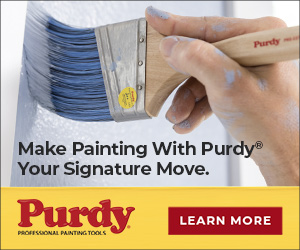Pro Picks
Can a professional painter be defined by the primer he or she uses? Perhaps. Most pros will tell you that the kind of primer they use can be the difference between a happy customer and one who never returns.
We recently asked several industry experts for their go-to choices for primer products. Here’s what they had to say:
OUR PANEL OF EXPERTS:
 FROM OUR PRO: Todd Miller has been in the painting business for nearly 30 years, and more than five years in his current role as general manager at Summit Paint Centers. His Akron-based company serves a client mix of retail, contractors and industrial-maintenance customers.
FROM OUR PRO: Todd Miller has been in the painting business for nearly 30 years, and more than five years in his current role as general manager at Summit Paint Centers. His Akron-based company serves a client mix of retail, contractors and industrial-maintenance customers.
For new construction, Miller says he likes to use PPG’s Speedhide Latex Sealer. “It’s great for new drywall and plaster—it is relatively inexpensive, yet hides and seals the surface very well.” “Over existing paint, my first choice is PPG’s Seal Grip Acrylic Universal Primer/ Sealer. It can be used inside or outside.”
Miller says it’s important to use a primer you can trust. “Use the right primer for the job. Multipurpose primers are useful but usually cost more than other primers. Because they have to work on a variety of substrates, they may perform better in one situation but not as well in another. Next to surface preparation, using the right primer is of utmost importance for the performance and longevity of the finish.”
FROM OUR PRO: Lisa Autry took a less-traditional path to get to where she is today. She opened an art school in Charlotte, NC in 1990, which she sold 10 years later to pursue a career as an artist and designer for commercial and residential venues, focusing on murals and decorative painting. For the past several years, she has been working in liturgical art. Her clients include priests, homeowners and designers.
“My go-to primer for new construction is Sherwin-Williams’ PrepRite ProBlock Primer/Sealer. Over existing paints, it depends on the type of paint that was originally used to finish the surface … if the surface was painted with an oil, I would, of course, use an oil-based primer. If I am unsure of what the surface originally was painted with (such as in a faux finish), I will always fall back on a good, fast-drying oil primer,” Autry says.
“Any finish is only as good as the substrate it is applied to. Primer is as essential as the finishing touch. You can skimp on this step and no one knows, but in the end it will eventually fail and the work will need to be redone.”
Like a good wood worker measures twice and cuts once, Autry says a professional painter preps right and never has to worry about returning to redo it or, worse yet, have an unhappy client.
FROM OUR PRO: Erik Nadoban has more than 20 years in the industry. As president of Nadoban Interiors, Inc., his East Coast company specializes in level-5 drywall finishes and high-end plastering, painting, and full renovations. “We specialize in level-5 finishes, so we tend to work on higher-quality renovations.”
“I prefer Benjamin Moore’s Fresh Start Multi-Purpose Oil-Based Primer. It seals freshly skimmed walls as well as drywall, and provides a good sanding base for the paint. On skimmed walls, I use their Fresh Start Enamel Underbody Primer if very high quality is desired. It levels the surface amazingly well and produces a very smooth look.”
FROM OUR PRO: In the three-plus decades he’s been in business, Ted Wetzel has seen a ton of change in the paint industry. He understands the importance of doing quality work, providing good customer service, and using the right products for the right job. And in many cases, it starts with the primer. “You must have full confidence in the primer that you use because it is the foundation of the final coat,” he says.
For new construction, Wetzel likes PPG’s Speedhide Interior MaxPrime Latex Primer/Surfacer, which he says is great for priming interior walls.
“Over existing paint, I like PPG’s Sun-Proof Exterior House & Trim Flat Latex Primer. It’s good for priming previously painted wood, siding and trim. Different substrates require different primers, so make sure to understand the characteristics of the surface you’re painting to choose correctly.”
FROM OUR PRO: Scott Walsh was once a painter for Boston’s Symphony Hall, and prior to that, he owned his own painting company, so he understands the importance of quality work. Today, he’s the foreman at Catchlight Painting, Inc. Walsh says his company works on high-end interior projects ranging from historic-home renovation/repaints to newly constructed homes in the Boston area. “Our customers are expecting the highest quality of work and paint finish. Depending on the project, it can be a very challenging position at times, but very rewarding,” he says.
“My go-to primer for new construction is Benjamin Moore’s Latex Fresh Start. It’s a very versatile primer with easy application and quick dry time. So being able to use the same product on new drywall, wood trim, and even metal and PVC is very helpful. It is actually one of my favorite paints overall.”
Walsh says he usually opts for a self-priming paint, such as Benjamin Moore’s Aura or Regal Select when priming over existing paint projects.
“Mainly for color changes and areas where minimal prep is needed, I try to use only acrylic primer and paint products. But for tough stains and sealing, I use Zinsser Odorless Oil-Base Stain Blocker. It works on pretty much everything. While it still has the oil-paint smell, it is much lower odor than other alkyds.”




